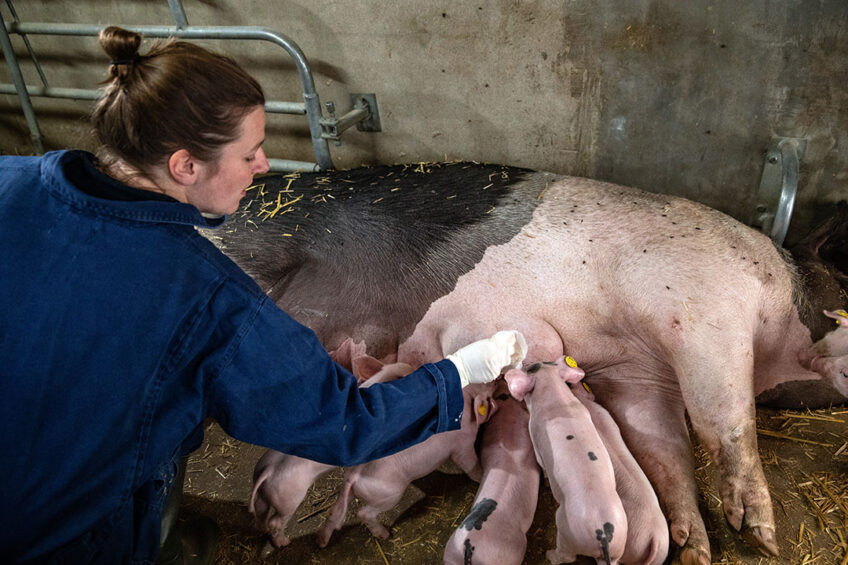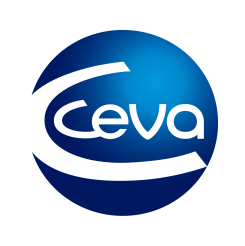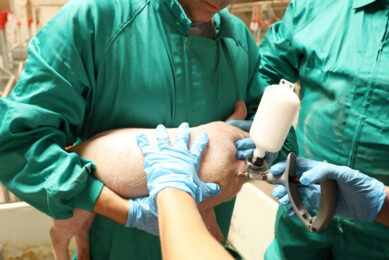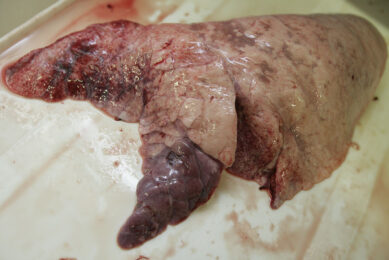Large-scale vaccination against swine flu (part II)

The first episode in this two-part series showed that influenza viruses are circulating in a large proportion of the pig herd in Europe. This article describes how pig vaccination could help avert the next global influenza pandemic.
While sows make up only about 10% of the total pig population on-farm, their non-vaccinated offspring represent a vulnerable group of animals that can keep virus circulating. Maternally derived antibodies that piglets receive from their vaccinated mothers are able to protect piglets from clinical signs, but infection still occurs. Vaccination strategies implemented on-farm should therefore also include piglets and fatteners: not only can they be a source of reassortment, but infection also causes huge economic impact due to reduced daily weight gain and increased use of medication.
Trials have shown that vaccination is effective in preventing clinical disease from all the circulating swine flu strains. However, to protect against most lineages of influenza A circulating in pigs in Europe, a combination of two vaccines – a trivalent covering H1N1, H1N2 and H3N2 and a vaccine with H1N1 pandemic strain – is required.
While it is true that vaccines cannot totally eliminate virus, they prevent clinical disease and significantly reduce the amount of virus in circulation, thereby reducing the opportunity for viruses to mix, exchange genetic material and emerge as new, potentially pandemic strains. Vaccines against swine flu for pigs are much more effective in preventing clinical disease than flu vaccines used in people. It is therefore ironic that the widespread use of the vaccines in people is widely accepted, while the use of much more effective vaccines in pigs is sometimes questioned.
Increasing efficacy of flu vaccines
Several strategies can be used to further increase the efficacy of swine flu vaccines used in pigs. All pig vaccines against swine flu licensed in Europe include the use of adjuvants in the vaccine composition. Adjuvants are certain types of chemicals that specifically stimulate the immune system and may potentiate vaccine efficacy.
The disadvantage of adjuvants is that they may cause more local reactions, such as swelling at the site of injection, and also short-lived systemic reactions, such as fever or pain. For that reason, adjuvants are not often used in most human flu vaccines. Only in exceptional cases, an adjuvant could be used because immune responses of older people are generally weaker than those of younger people.
Most influenza vaccines for use in people contain small fragments of virus particles from a number of different strains. Trivalent or, increasingly, tetravalent vaccines, containing viral particles from three or four different strains, are most commonly used throughout the world. In contrast, pig vaccines are made from whole, inactivated viruses: Ceva’s RespiporcFLU3 vaccine contains whole inactivated viruses of three strains of swine flu virus which between them cover three of the four major lineages of influenza A virus; ResiporcFLUpanH1N1 contains whole inactivated virus from a strain originally isolated from a human case of influenza. So, while the human vaccines mostly contain just the viral proteins that are the major determinants that induce protective immunity, the pig vaccines contain the full range of viral structural proteins. Some of those additional proteins may also induce immunity and thereby boost the efficacy of the vaccines, and may also provide broader protection against a wider range of strains.
New seasonal flu vaccines
Each year, new seasonal flu vaccines are produced for people which are designed to closely match the influenza strains circulating that year. The regulatory authorities allow human vaccine manufacturers to replace the stains included in annual flu vaccines based on the recommended strains, providing certain standard procedures are followed. Current regulations controlling the use of veterinary vaccines in Europe preclude that option: changing the strains used in the currently licensed pig vaccines would necessitate a mandatory and lengthy approval process which would be impractical and uneconomic for vaccine manufacturers.
As noted previously, pigs can become infected with swine flu strains from other pigs, birds and people. Of those, people are likely to be the major source of infection: although the disease is called “swine flu”, from a pig’s perspective it would actually be human flu. For that reason, pig farmers and other people who come into contact with pigs should be encouraged to have their annual flu vaccination.
In addition to vaccination of pigs and people, adoption of effective biosecurity measures can help to prevent virus circulation between pigs and also reduce the incidence of secondary bacterial infections, as the influenza virus and other pathogens can adhere to any surface and be transmitted by both inanimate and animate vectors. Measures include:
- All-in, all-out rearing systems for piglets;
- Deep cleans between batches;
- Avoiding crossing walkways;
- Clothes and shoe changing when staff move between production stages;
- Colour-coded equipment for individual areas.
Changing attitudes post-Covid
Covid-19 has very clearly demonstrated the enormous economic and human cost associated with a global pandemic of a respiratory virus. The global population of pigs has grown steadily over the past decades, from around 400 million in the early 1960s to close to one billion today. At the same time, the average size of pig farms has also increased. Throughout the world, small, backyard pig production has given way to large, commercial pig units.
Whereas in the 1990s a large pig farm would have 200 breeding sows, now many farms have thousands or even tens of thousands of sows. These changes in the way pigs are reared, combined with the fact that pigs serve as very efficient hosts for influenza viruses from pigs, birds and people to mix and swap genetic material, make it increasingly likely that the next global influenza pandemic will arise in pigs.
Animals vaccinated with the trivalent vaccine have shown reduced shedding and reduced clinical signs after infection with an H1N1 virus that emerged in 2010. That was shown by a team of researchers led by Álvaro López-Valiñas, attached to the Catalan research institute CReSA-IRTA in 2021. Even more important was the finding that vaccinated animals reduced the probability of the production of new reassortants. The authors stated: “Stricter vaccination schedules should be carried out on farms to avoid maximum SIV [swine influenza viruses] circulation, increasing the current percentage of swine population vaccinated against SIV in Europe (10–20%).”
Reducing disease and boosting productivity
Mass vaccination of sows and their offspring against swine flu would deliver direct benefits to pig farmers – reducing disease and boosting productivity in ways that are highly cost-effective. If such a strategy could also avert the next global pandemic, the return on investment would be incalculable, not to mention the human suffering prevented and lives saved.
Now, therefore, appears to be a very good time to make vets, pig farmers and public health authorities aware of the potential benefits of vaccinating pig herds. The big question that still needs answering, however – as is the case with all diseases that can spread from animals to people – is who pays and who benefits? It is to be hoped that the world’s public health and veterinary authorities can answer that question before the next global pandemic strikes.
The previous article in this series was published in Pig Progress 38.02.
References available upon request at kathrin.lillie-jaschinski@ceva.com and friederike.schmelz@ceva.com.






